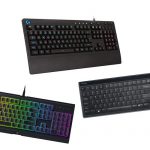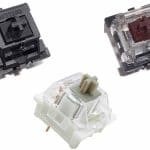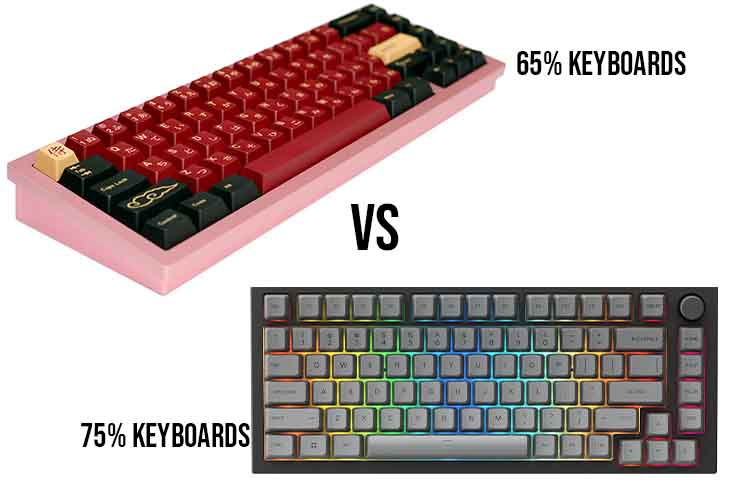
65% and 75% keyboards are both currently popular in the keyboard community. Both feature a smaller footprint compared to traditional full-size keyboards. Both keyboard sizes also feature unique design elements that make them more interesting than other keyboard sizes.
Both keyboard form factors have their unique appeal. 75% keyboards are preferred by gamers and users who heavily rely on the function row. 65% keyboards, on the other hand, appeal to those who want the smallest keyboard that still has arrow keys. Either way, the better keyboard will depend on the user’s preference.
In this article, we will be comparing these two keyboard sizes in more detail. We’ll go over all the features that make them desirable and some downsides that consumers have to consider. And by the end, our readers should have a better idea of which keyboard size will fit them.
Summary of 65% Keyboards
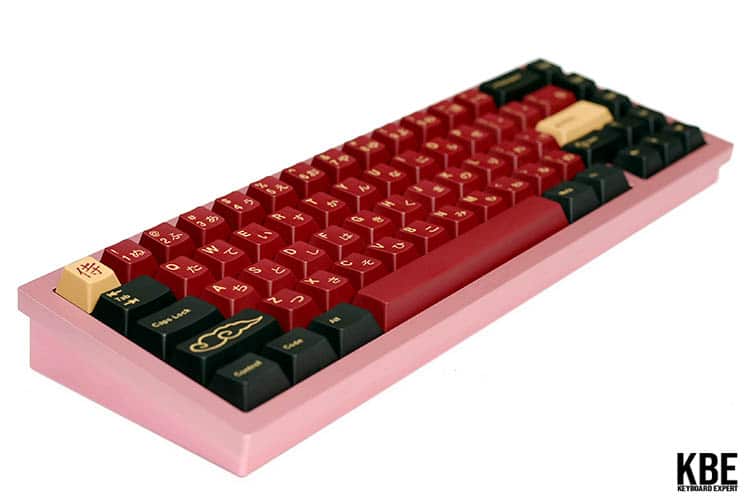
65% keyboards are modified variants of the 60% form factor. What makes the 65% keyboards better are the extra featured keys that aid in providing a fuller keyboard experience.
The majority of 65 percent keyboards contain 68 keys, which is 7 keys more than 60% keyboards. The extra keys that 65% keyboards provide serve to be very useful for people who are used to large form factors like full-size and tenkeyless keyboards that are tying out smaller keyboards.
65% keyboards are compact yet still allow the user to use arrow keys and three essential keys that can be programmed depending on the user’s preference.
The compact design is suggested to users who wish to maximize their desk space but still prefer the extra keys 65% keyboards provide. Furthermore, this form factor is travel-friendly for its size, suitable for people who prefer to bring their own keyboard at work.
Pros of 65% Keyboards
- Portable and travel-friendly.
- Takes up less desk space,
- Compact but still provides seven extra keys to improve productivity.
Cons of 65% Keyboards
- Does not have function keys.
- Limited in Terms of Third-Party Case Options.
Popular 65% Custom and Prebuilt Keyboards
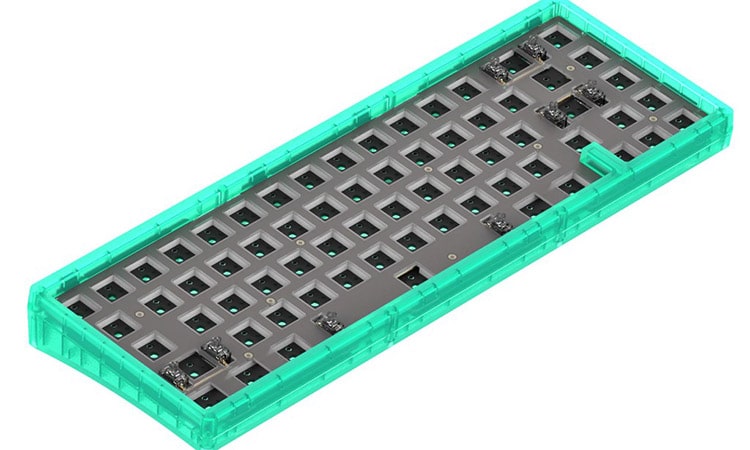
Examples of 65% custom keyboards available in the market include the KBDFans KBD67 Lite and Tofu65, Wuque Studio ikki68 Aurora, Graystudio Think6.5v2 and Space65 R2, Keychron Q2, and the Mode SixtyFive. There are also budget custom keyboards such as the Tom680 and Keydous NJ68.
In terms of prebuilt 65% keyboards, popular options include the Ducky Miya Pro, Leopold F660M, Epomaker GK68XS, Keychron K6, and Akko‘s 3068B and MOD005.
Summary of 75% Keyboards
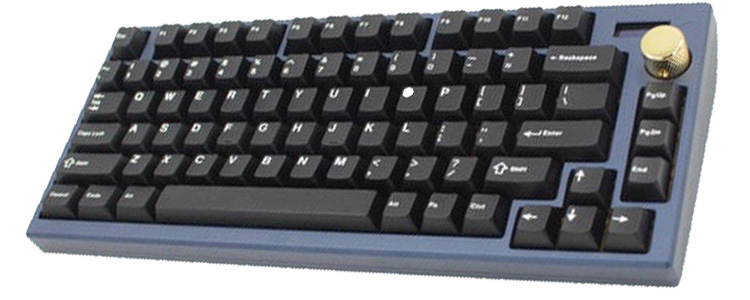
75% keyboards are considered the most functional yet practical keyboard options for those who want to save space but still can’t let go of their arrow keys.
However, this form factor does not have a number pad and has fewer navigational keys than a standard tenkeyless board. The navigation keys are usually placed on the right side of the board in a vertical line that contains the end, delete, page up, and page down keys at default. Lastly, it still has the arrow keys for functionality.
There are also different types of 75% keyboard like the exploded version where the keyboard is divided by narrow spaces into 4 sections: the alphas and modifiers, the arrow keys, the navigation keys, and the function keys at the top of the board. On the other hand, compact 75% keyboards are where the sections are compiled together to make them more compressed.
Most newly-released 75% keyboards in the market also offer unique features like the rotary encoder and OLED displays, which increases the help in productivity. These features and the navigation keys, can also be programmed via QMK and VIA or any third-party software to accommodate the user’s preferences.
Pros of 75% Keyboards
- Includes the function keys and more navigation keys that the user can program,
- Newly-released 75% keyboard has unique features such as rotary encoders and OLED displays.
- Compact and sleek design that does not take too much desk space.
Cons of 75% Keyboards
- Bigger than 65% keyboards, which are less likely to be travel friendly.
- It also has limited Third-Party case options due to its unique design.
Popular 75% Custom and Prebuilt Keyboards
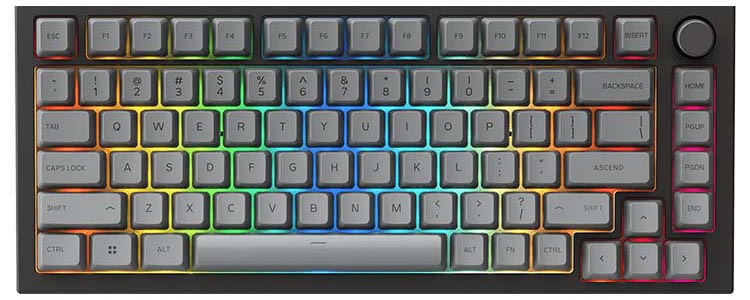
Popular custom 75% keyboards include the GMMK Pro, Keychron Q1, Cannonkeys Satisfaction75, KBFDans KBD75, Idobao ID80 and ID80, and Owlabs’ Jelly Epoch. Some popular budget custom keyboard options include the Feker’s IK75. Budget options are currently more limited compared to 65% keyboards meaning there are fewer options to choose from.
In terms of prebuilt keyboards, popular options include the Keychron K2 and K3, Royal Kludge RK84, Keydous NJ80, NuPhy Air75, Iqunix L80 Formula, and the Vortexgear Race 3. Similar to 65% keyboards, most prebuilt 75% either lack the hot-swappable feature or are on the more budget-friendly side. However, you can always choose Custom Pre-built keyboards for a higher price.
65% and 75% Keycap Compatibility
The keycap compatibility of the 65% and the 75% keyboards are similar as it only requires the right shift to be 1.75u in size. The good thing is most keycaps sets include a 1.75 shift key, but it is still best to check the description if they have one. The only other difference they have is that 75% keyboards require function row keycaps.
Which is the Better Keyboard Form Factor?
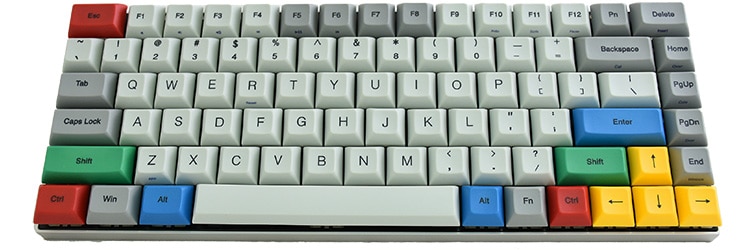
If we are talking about functionality and productivity, the 75% keyboards are still the best option. It has all the necessary features, is still compact, and has a very sleek design. Some 75% keyboards also have unique features like the Keychron Q1, where you can either install a rotary knob or different custom badges depending on your preference.
However, 65% are most suitable for those with limited desk space or people who travel with their keyboards since they are more compact. The only thing that you will think about is if you really need the function keys. If not, then go for a 65% keyboard.

